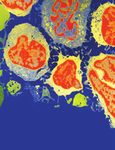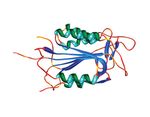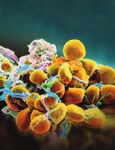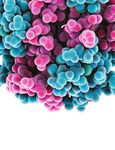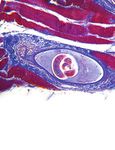Case Report Secondary Hemophagocytic Lymphohistiocytosis: A Challenging Diagnosis in a Patient with Autoimmune Hepatitis
←
→
Page content transcription
If your browser does not render page correctly, please read the page content below
Hindawi
Case Reports in Critical Care
Volume 2019, Article ID 3580796, 4 pages
https://doi.org/10.1155/2019/3580796
Case Report
Secondary Hemophagocytic Lymphohistiocytosis: A Challenging
Diagnosis in a Patient with Autoimmune Hepatitis
Colin Casault and Juan G. Posadas-Calleja
Department of Critical Care Medicine, University of Calgary, Alberta, Canada
Correspondence should be addressed to Colin Casault; casaultc@gmail.com
Received 5 November 2018; Revised 27 December 2018; Accepted 13 January 2019; Published 4 February 2019
Academic Editor: Mehmet Doganay
Copyright © 2019 Colin Casault and Juan G. Posadas-Calleja. This is an open access article distributed under the Creative
Commons Attribution License, which permits unrestricted use, distribution, and reproduction in any medium, provided the
original work is properly cited.
Background. We describe a case of secondary Hemophagocytic Lymphohistiocytosis (HLH) from autoimmune hepatitis mimicking
severe sepsis in a man admitted to the intensive care unit. Case Presentation. A 34-year-old Pakistani male with a prior
history of biopsy-proven autoimmune hepatitis presented to a regional hospital with severe fever, cytopenias, hyperferritinemia,
hypertriglyceridemia, splenomegaly, and a bone marrow biopsy showing hemophagocytosis. After ruling out mimicking
conditions, a diagnosis of HLH was made using the HLH-2004 diagnostic criteria. He was treated with dexamethasone and
etoposide, without bone marrow transplantation (BMT) due to poor functional status. At one-year after follow-up, he had returned
to his baseline functional status without recurrence. Conclusion. We describe a rare case of secondary HLH in the setting of
autoimmune hepatitis. Broadly, this case report educates clinicians to consider this potentially missed diagnosis. This case also
informs clinicians that treatment of secondary HLH with BMT may not be necessary for the management of secondary HLH due
to autoimmune hepatitis. Finally, it provides a detailed description of the natural history of a single patient with secondary HLH
due to autoimmune hepatitis.
1. Case Presentation Due to suspected sepsis and severe alcohol withdrawal,
he was transferred to the ICU for intubation and agitation
A 34-year-old male with stage IV cirrhosis secondary to management. Additionally, broad-spectrum antimicrobial
autoimmune hepatitis (AH) and concomitant alcoholism treatment was initiated with coverage for spontaneous bac-
presented to a regional hospital emergency room with fever, terial peritonitis and presumed community-acquired menin-
vomiting, and altered mentation in the setting of presumed gitis with meropenem, vancomycin, and acyclovir. Over the
alcohol withdrawal. His prior diagnosis of AH was made coming four days, his level of consciousness continued to
two years’ prior via transhepatic biopsy and treatment was decline and he developed seizures.
initiated with azathioprine and prednisone; however, the
patient was nonadherent. He immigrated from Pakistan in 2. Investigations
2009 and was married with a 4-year-old daughter with no
family history of autoimmunity. Diagnostic workup revealed severe acute thrombocytope-
At the initial assessment, the patient was hyperthermic at nia (9000/mm3) and neutropenia (1100/mm3) compared to
41.5∘ C, tachycardic with a heart rate of 132 beats per minute, normal values a week prior. Blood chemistry demonstrated
and tachypneic at 24 breaths per minute with normal oxygen a mixed cholestatic and hepatocellular enzyme elevation.
saturation. Bedside examination revealed livedo reticularis of Over four days, AST values increased rapidly to 2388 IU/L
his lower extremities with palmar erythema and spider nevi. with worsening direct hyperbilirubinemia (40 mcg-mol/L).
His abdomen was slightly firm with tenderness in his right Synthetic function demonstrated an INR of 1.2, normal
upper quadrant. No organomegaly or peritoneal signs were glucose and hypoalbuminemia (25g/L). CT imaging of the
identified. chest, abdomen and pelvis showed enlargement of the2 Case Reports in Critical Care
4. Discussion
HLH is a rare clinical syndrome, marked by excessive im-
mune activation causing fever, hepatosplenomegaly, cytope-
nias, and organ infiltration by activated macrophages, which
has an incidence of 1 per 800,000 adults per year [1]. HLH
can be categorized into primary and secondary HLH. The
former category encapsulates five genetic forms of HLH,
which include mutations in Perforin-1, UNC13D, STX11,
and STXBP2 proteins [2]. Mutation in the aforementioned
proteins leads to impaired natural killer (NK) cell or cyto-
toxic T-cell activity due to ineffective perforin function or
ineffective trafficking, docking and exocytosis of perforin-
containing granules. As a result of impaired killing function,
NK and cytotoxic T-cells excessively release cytokines and
cause immune hyperactivation [2]. Comparatively, secondary
Figure 1: Bone marrow biopsy demonstrating a macrophage con- HLH represents cases due to a clear trigger which includes
taining a late stage erythroid precursor compatible with hemopha- both infectious and noninfectious etiologies. Noninfectious
gocytosis. triggers may include medications, autoimmune, neoplastic
and idiopathic causes. Why a patient develops secondary
HLH remains unclear, however experts theorize a “second
spleen with evidence of hepatic cirrhosis. Ferritin levels were hit hypothesis” may be important for its development. The
significantly elevated at greater than 8000 mcg/L with an “second hit hypothesis” describes a genetically susceptible
elevated triglyceride level at 10.35 mmol/L. Bone marrow individual, who requires a sufficient external pressure to
biopsy showed hemophagocytosis and increased macrophage manifest the features of HLH [2]. This theory is supported by
infiltration (see Figure 1). the discovery of associated genetic polymorphisms involved
Infectious workup included extensive blood and urine in granule-mediated cytotoxicity, microtubule organization,
testing for Hepatitis A, B, C, HIV, herpes simplex, vari- vesicular transport, NK-cell receptors, and many other path-
cella, cytomegalovirus (CMV), Epstein Barr Virus (EBV), ways involved in immune regulation [2].
acid-fast bacilli, and respiratory viruses. Bone marrow test- Establishing the correct diagnosis of HLH can be chal-
ing for leishmaniasis was negative. Rheumatologic workup lenging as the clinical manifestations and investigations
yielded a >1:640 speckled ANA pattern, with positive beta- are akin to septicemia. Fever, encephalopathy, leucopenia,
2 microglobulin and lupus type inhibitors present. Extensive thrombocytopenia, and hypofibrinogenemia may be present
workup demonstrated normal C3/4, dsDNA, anti-cardiolipin in both septic patients and those with HLH. Therefore,
antibodies, MPO/PR3, anti-smith, AMA, ANCAs, anti- systematic evaluation for both infectious and noninfectious
GBM, and HLA phenotyping were all normal. Toxic alcohol contributors remains essential. Viral infections, specifically
screen was similarly negative. Repeat transhepatic biopsy from the herpes family, including herpes simplex virus (62%),
demonstrated known cirrhosis and no evidence of on-going EBV (43%), and CMV (9%), are the most common triggers
AH. Finally, evaluation for malignancy including enhanced [1, 3]. Bacterial causes, most often tuberculosis, have been
body CT imaging, serum flow cytometry, and immunoglob- reported in up to 9% [1]. In the immunosuppressed, HLH
ulins were all normal. may be related to opportunistic infection such as toxoplas-
mosis or fungi [4, 5]. Secondary HLH has also been described
as a complication of autoimmune disease, including SLE and
3. Management and Clinical Follow-Up
Adult-Onset Still’s Disease (AOSD) with a prevalence of 4.6%
In consultation with Rheumatology and Hematology, his [6]. Most commonly in the setting of autoimmunity, cases of
clinical presentation was in keeping with a diagnosis of HLH are related to infection due to immunosuppression or
Hemophagocytic Lymphohistiocytosis (HLH). Treatment malignancy [7, 8]. In the absence of other cause, autoimmune
was initiated with modified HLH-94 therapy including conditions may predispose one to develop HLH due to
etoposide and dexamethasone chemotherapy. Intrathecal prolonged stimulation of the innate immune system. The
methotrexate was considered, however, forgone secondary to resulting cytokine storm causes functional NK-cell impair-
poor premorbid functional status, severe thrombocytopenia, ment which further contributes to hypercytokinemia [9].
and significant hepatic dysfunction. After ruling out other cause, the diagnosis of HLH can
He underwent five months of chemotherapy with clinical be made using the HLH-2004 criteria (Table 1) [1]. In our
response measured in improving hepatic and hematologic case, acute onset cytopenias, hyperferritinemia, hypertriglyc-
parameters. Consolidative bone marrow transplantation was eridemia, fever, splenomegaly, and a bone marrow biopsy
not completed as he was not deemed medically fit under showing hemophagocytosis in the absence of other causes
the guidance of hematology. Approximately one-year after confirmed the diagnosis of HLH. However, the limitations of
diagnosis, he remains in remission with on-going close the HLH-2004 criteria should be acknowledged. They were
hematology follow-up. initially chosen to describe a pediatric population of mainlyCase Reports in Critical Care 3
Table 1: HLH-2004 diagnostic guidelines[1].
Criteria
Fever >38.5∘ C or more
Splenomegaly Present
Cytopenias 2 cell lines
Hemoglobin < 90 mmol/L
Thrombocytopenia < 100 x 109 /L
Neutropenia < 1 x 109 /L
Hyperferritinemia > 1123.5 pmol/L
Hypertriglyceridemia(fasting) and/or hypofibrinogenemia > 3 mmol/L and/or < 1.7 mmol/L
Pathologic evidence in the bone marrow, spleen, lymph
Hemophagocytosis
nodes or liver
Soluble CD25 levels (alpha chain of the soluble interleukin 2 receptor) Elevated
Natural-killer-cell activity Low or absent
OR
Pathological mutations of PRF1, UNC13D, STXBP1,
Molecular Diagnosis consistent with HLH
RAB27A, STX11, SH2D1A or XIAP
primary, not secondary HLH. This precedent is reflected in normalized. All three cases attained remission after immuno-
the criteria by the inclusion of molecular markers which suppression with corticosteroids and additional adjuvant
are rarely present in adult HLH. Moreover, systemic organ treatment. Interestingly, AH has been observed to precede
dysfunction may mimic some features of the HLH-2004 a diagnosis of primary HLH with marked hypogammaglob-
diagnostic criteria. For example, hepatic cirrhosis may cause ulinemia and atypical focal brain lesions due to STXBP2
thrombocytopenia, hypofibrinogenemia, and splenomegaly. mutation [13]. In comparison to the above cases, this patient
In our case, the development of acute onset, severe thrombo- died soon after the diagnosis during HLH-2004 induction
cytopenia, in the context of the supporting clinical features, chemotherapy due to sepsis.
implies the development of a secondary contributing process Mortality risk in HLH appears to be dependent on the
rather than splenic sequestration. Clinicians should be cau- trigger, which underscores the importance of establishing the
tious about applying the HLH-2004 criteria in the setting diagnosis. Regardless of cause, adult HLH carries a significant
of confounding variables. Acknowledging this discrepancy, mortality risk of 69% with a median overall survival of
Fardet et al. developed the h-score, a probability model 4 months. Poor prognostic factors in HLH include age,
based on data collected from a multicenter adult cohort with thrombocytopenia, and etiology [14]. HLH secondary to
secondary HLH [10]. With a score of >169, the h-score yielded autoimmunity appears to have a more favorable prognosis
a sensitivity and specificity of 93% and 86%, respectively, for with an overall mortality of 13% [15]. All three AH cases
the diagnosis of a hemophagocytic syndrome. Applying this with secondary HLH described above demonstrated clinical
knowledge to our case, our patient’s h-score was 264, reflec- remission after immunosuppression. This appears supportive
tive of a >99% probability of a hemophagocytic syndrome. that HLH secondary to AH may be more amenable to
Specific to AH, cases are rare, and the natural history less intensive treatment regimens than other forms of sec-
remains unclear. Saito et al. report a 15-year-old woman ondary HLH. More extensive studies are required to evaluate
with probable AH and secondary HLH who demonstrated whether patients with AH and HLH carry a more favorable
clinical remission after treatment with prednisolone and prognosis.
cyclosporine A [11]. Similarly, Hayashi et al. describe a
60-year-old woman with drug-induced definite AH and 5. Conclusion
secondary HLH who responded to treatment with plasma
exchange and immunosuppression with prednisolone [12]. Differentiating between septicemia and secondary HLH is a
Both cases presented with acute hepatic failure without coma, diagnostic challenge. Both share many common clinical fea-
cytopenias, positive ANA testing, hypergammaglobulinemia, tures including severe fevers, cytopenias, hyperferritinemia,
with an absence of fever and met only four HLH-2004 and hypofibrinogenemia with treatment pathways differing
criteria. As such, the diagnosis of AH and HLH were made dramatically. Utilization of the HLH-2004 diagnostic criteria
concurrently. Alternatively, our patient presented with an or other clinical scoring systems, like the h-score, may help
established diagnosis of AH, based on hepatic biopsy, ANA identify at-risk patients and multidisciplinary expertise can
positivity, and elevated IgG levels, followed two years later by help secure a diagnosis. Our case provides an excellent
a fulminant presentation with severe fevers, mixed hepatic example for the challenges of diagnosing secondary HLH as
dysfunction, cytopenias, coma, seizures and met 6 HLH- we report a rare patient suffering from secondary HLH from
2004 diagnostic criteria. At that time, normal IgG levels had AH.4 Case Reports in Critical Care
Additional Points [2] E. Brisse, C. H. Wouters, and P. Matthys, “Advances in the
pathogenesis of primary and secondary haemophagocytic lym-
Key Points. (i) HLH is a rare, life threatening condition with phohistiocytosis: Differences and similarities,” British Journal of
two described forms: Primary and Secondary. (ii) Secondary Haematology, vol. 174, no. 2, pp. 203–217, 2016.
HLH, primarily seen in adults, is often initiated by an [3] H. Kikuta, “Epstein-Barr virus-associated hemophagocytic syn-
infectious, malignancy, medication, or autoimmune related drome,” Leukemia & Lymphoma, vol. 16, no. 5-6, pp. 425–429,
trigger. (iii) Due to the nonspecific symptoms and high 1995.
mortality, a high degree of clinical suspicion is required to [4] L. Fardet, O. Lambotte, J.-L. Meynard et al., “Reactive hae-
differentiate between septic shock and HLH. (iv) Knowledge mophagocytic syndrome in 58 HIV-1-infected patients: Clinical
of the HLH-2004 diagnostic criteria or use of a probability features, underlying diseases and prognosis,” AIDS, vol. 24, no.
score like the h-score reduces the likelihood of missing the 9, pp. 1299–1306, 2010.
diagnosis. [5] A. Karras, E. Thervet, C. Legendre, and Groupe Cooperatif de
transplantation d’Ile de France, “Hemophagocytic syndrome
Abbreviations in renal transplant recipients: report of 17 cases and review of
literature,” Transplantation, vol. 77, no. 2, pp. 238–243, 2004.
ASOD: Adult-Onset Still’s Disease [6] M. Atteritano, A. David, G. Bagnato et al., “Haemophagocytic
AH: Autoimmune hepatitis syndrome in rheumatic patients. A systematic review,” European
BMT: Bone marrow transplantation Review for Medical and Pharmacological Sciences, vol. 16, no. 10,
CMV: Cytomegalovirus pp. 1414–1424, 2012.
EBV: Epstein Barr Virus [7] R. Dhote, J. Simon, T. Papo et al., “Reactive hemophagocytic
HLH: Hemophagocytic Lymphohistiocytosis syndrome in adult systemic disease: report of twenty-six cases
ICU: Intensive Care Unit and literature review,” Arthritis Care & Research, vol. 49, no. 5,
NK: Natural Killer. pp. 633–639, 2003.
[8] W. Fries, M. Cottone, and A. Cascio, “Systematic review:
Data Availability macrophage activation syndrome in inflammatory bowel dis-
ease,” Alimentary Pharmacology & Therapeutics, vol. 37, no. 11,
Data sharing is not applicable to this article as no datasets pp. 1033–1045, 2013.
were generated or analyzed during the current study. [9] K. Lehmberg, I. Pink, C. Eulenburg, K. Beutel, A. Maul-Pavicic,
and G. Janka, “Differentiating macrophage activation syndrome
Consent in systemic juvenile idiopathic arthritis from other forms of
hemophagocytic lymphohistiocytosis,” Journal of Pediatrics,
This case report was collected and published with the vol. 162, no. 6, pp. 1245–1251, 2013.
informed, written consent of the patient. [10] L. Fardet, L. Galicier, O. Lambotte et al., “Development and
validation of the hscore, a score for the diagnosis of reactive
hemophagocytic syndrome,” Arthritis & Rheumatology, vol. 66,
Conflicts of Interest no. 9, pp. 2613–2620, 2014.
The authors, Colin Casault & Juan G. Posadas-Calleja, have [11] M. Saito, Y. Yano, A. Minami et al., “Autoimmune-associated
no conflicts of interest to declare. hemophagocytic syndrome originating from autoimmune hep-
atitis with a successful response to therapy,” Internal Medicine,
vol. 53, no. 2, pp. 103–107, 2014.
Authors’ Contributions [12] M. Hayashi, K. Abe, H. Imaizumi et al., “Drug-induced
liver injury with autoimmune features complicated with
Colin Casault collected the patient data, performed the liter- hemophagocytic syndrome,” Clinical Journal of Gastroenterol-
ature review, and developed the manuscript for publication. ogy, vol. 9, no. 3, pp. 150–155, 2016.
Juan G. Posadas-Calleja contributed to the literature review [13] H. Esmaeilzadeh, M. H. Bemanian, M. Nabavi et al., “Novel
and manuscript development. patient with late-onset familial hemophagocytic lymphohisti-
ocytosis with stxbp2 mutations presenting with autoimmune
Acknowledgments hepatitis, neurological manifestations and infections associated
with hypogammaglobulinemia,” Journal of Clinical Immunol-
The authors would like to thank the University of Calgary ogy, vol. 35, no. 1, pp. 22–25, 2015.
Department of Critical Care for their on-going support. We [14] A. M. Schram, P. Comstock, M. Campo et al., “Haemophago-
would also like to thank Dr. Thomas Fourie for his pathology cytic lymphohistiocytosis in adults: a multicentre case series
contributions to the case. Finally, we would like to thank over 7 years,” British Journal of Haematology, vol. 172, no. 3, pp.
Kwadwo Mponponsuo for his role in helping collect the 412–419, 2016.
patient data for this case. [15] S. Kumakura and Y. Murakawa, “Clinical characteristics and
treatment outcomes of autoimmune-associated hemophago-
cytic syndrome in adults,” Arthritis & Rheumatology, vol. 66, no.
References 8, pp. 2297–2307, 2014.
[1] M. Ramos-Casals, P. Brito-Zerón, A. López-Guillermo, M. A.
Khamashta, and X. Bosch, “Adult haemophagocytic syndrome,”
The Lancet, vol. 383, no. 9927, pp. 1503–1516, 2014.MEDIATORS of
INFLAMMATION
The Scientific Gastroenterology Journal of
World Journal
Hindawi Publishing Corporation
Research and Practice
Hindawi
Hindawi
Diabetes Research
Hindawi
Disease Markers
Hindawi
www.hindawi.com Volume 2018
http://www.hindawi.com
www.hindawi.com Volume 2018
2013 www.hindawi.com Volume 2018 www.hindawi.com Volume 2018 www.hindawi.com Volume 2018
Journal of International Journal of
Immunology Research
Hindawi
Endocrinology
Hindawi
www.hindawi.com Volume 2018 www.hindawi.com Volume 2018
Submit your manuscripts at
www.hindawi.com
BioMed
PPAR Research
Hindawi
Research International
Hindawi
www.hindawi.com Volume 2018 www.hindawi.com Volume 2018
Journal of
Obesity
Evidence-Based
Journal of Stem Cells Complementary and Journal of
Ophthalmology
Hindawi
International
Hindawi
Alternative Medicine
Hindawi Hindawi
Oncology
Hindawi
www.hindawi.com Volume 2018 www.hindawi.com Volume 2018 www.hindawi.com Volume 2018 www.hindawi.com Volume 2018 www.hindawi.com Volume 2013
Parkinson’s
Disease
Computational and
Mathematical Methods
in Medicine
Behavioural
Neurology
AIDS
Research and Treatment
Oxidative Medicine and
Cellular Longevity
Hindawi Hindawi Hindawi Hindawi Hindawi
www.hindawi.com Volume 2018 www.hindawi.com Volume 2018 www.hindawi.com Volume 2018 www.hindawi.com Volume 2018 www.hindawi.com Volume 2018You can also read





